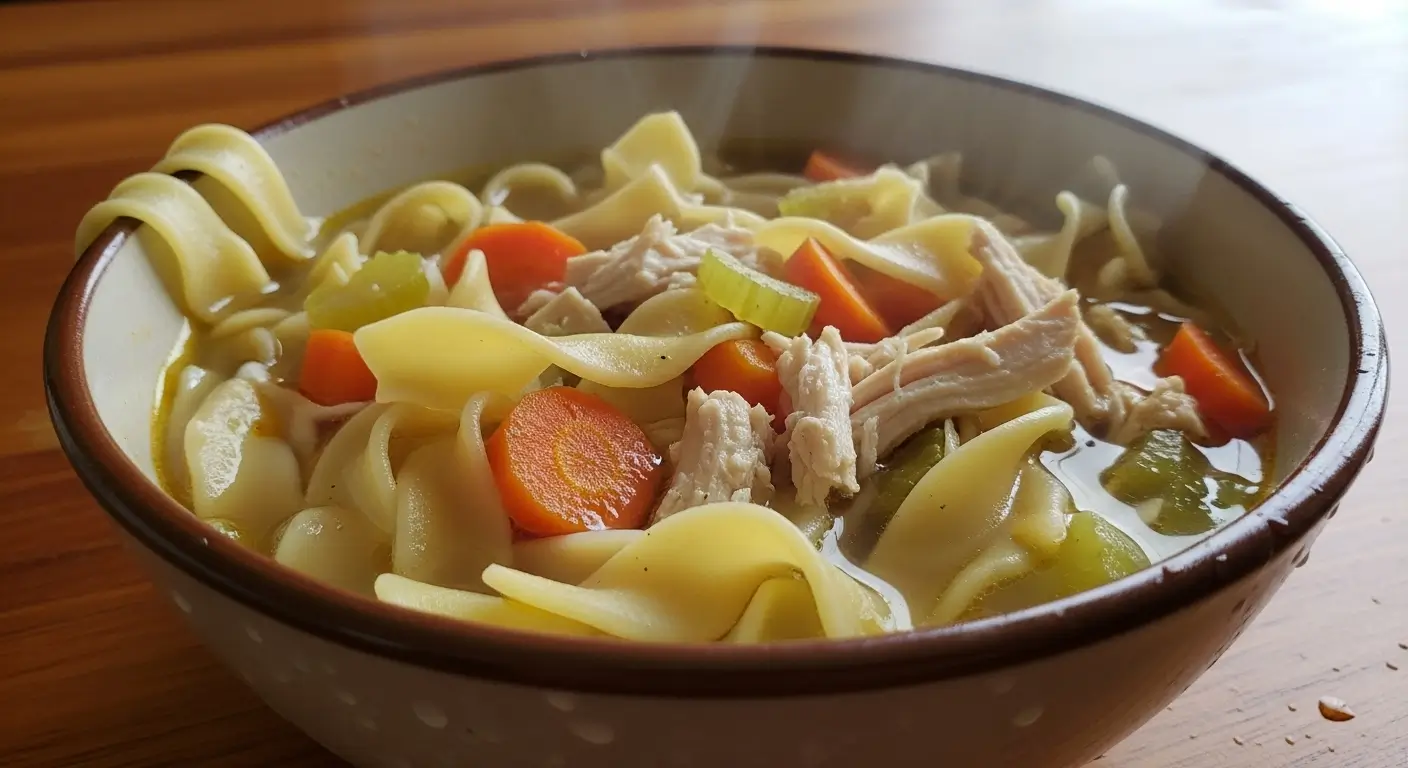The Best Chicken Noodle Soup Recipe (Trust Me, I’ve Messed This Up Enough Times)
Okay, so everyone keeps asking me for this chicken noodle soup recipe, and honestly? I’ve been putting off writing it down because I was convinced I’d jinx myself and suddenly forget how to make it. But here we are, and I’m gonna try to explain how I finally figured out the perfect bowl of comfort.
Look, I’m gonna be honest with you right up front – this took me way too many attempts to get right. Like, embarrassingly many. The first time I tried making chicken noodle soup from scratch, I ended up with what my husband lovingly called “chicken water with sad vegetables.” Not exactly the cozy, soul-warming bowl I was going for.
But here’s the thing about chicken noodle soup – it’s supposed to be simple, right? Wrong. Well, kinda wrong. The ingredients are simple, but getting that perfect balance of flavors? That rich, golden broth that doesn’t taste like it came from a can? That took some serious trial and error.
Table of Contents
My Chicken Noodle Soup Journey (AKA: How I Learned to Stop Worrying and Love the Stockpot)
This whole obsession started last winter when I was sick with the worst cold ever. You know the kind – where you can’t taste anything but somehow still crave your mom’s cooking? I called my mom for her chicken soup recipe, and she just laughed. “Honey, I just throw stuff in a pot until it tastes right.”
Thanks, Mom. Super helpful.
So I did what any reasonable person would do – I spent three hours on Pinterest looking at fifty different chicken noodle soup recipes. Big mistake. Every single one was different. Some said to use a whole chicken, others said boneless thighs, some insisted on egg noodles while others swore by regular pasta. I was more confused than when I started.
My first attempt was… well, let’s just say the dog wouldn’t even eat it. And my dog once ate an entire sock, so that’s saying something.
The problem was I was trying to be too fancy. I bought this expensive organic chicken stock, used these weird heirloom carrots that cost like five dollars, and spent forever trying to make perfect little dice cuts on my vegetables. The result? Bland, boring soup that looked pretty but tasted like nothing.
Disaster. Complete disaster.
But you know what? Sometimes the best lessons come from epic failures.
The Breakthrough (Or: How My Neighbor Accidentally Saved My Soup Game)
The turning point came about two months later. I was making another attempt – this time trying some complicated recipe that involved roasting the chicken first – when my neighbor knocked on the door. We got to talking about her garden, and I completely forgot about the chicken in the oven.
Twenty minutes later, I smelled something burning and ran back to the kitchen in a panic. The chicken was definitely overdone, but something weird had happened. The skin was this gorgeous golden brown, and when I pulled it out of the pan, there were all these amazing crispy bits stuck to the bottom.
Instead of throwing it out (which honestly was my first instinct), I decided to scrape up those brown bits and throw them in the pot with some water. Game changer. Those little burnt pieces – okay, not burnt, more like deeply caramelized – gave the broth this incredible depth of flavor I’d been missing.
That was my “aha!” moment. The secret wasn’t expensive ingredients or perfect knife skills. It was building layers of flavor, and sometimes that means embracing the happy accidents.
What You Actually Need (No Fancy Stuff Required)
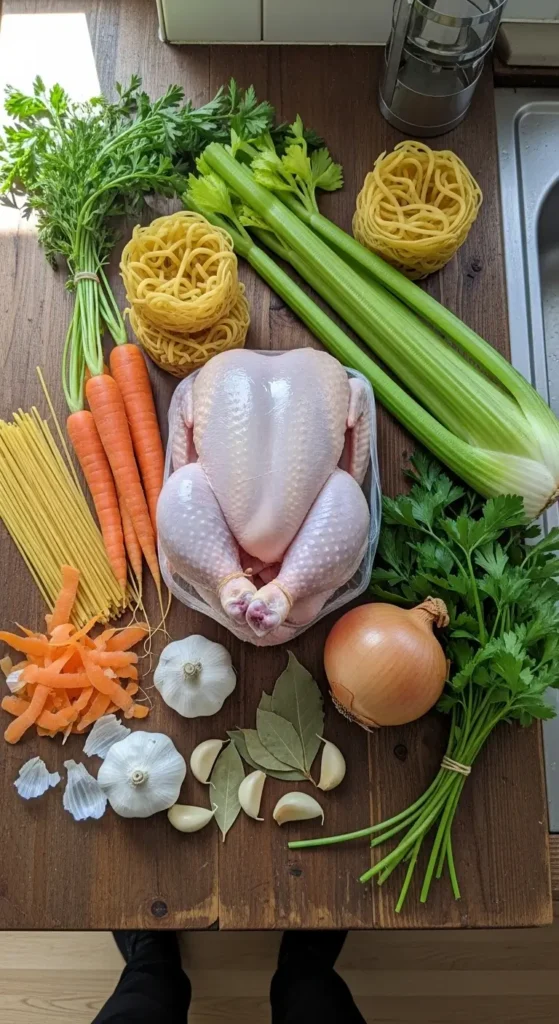
Here’s what I’ve learned works best, and I promise you probably have most of this stuff already:
For the broth:
- 1 whole chicken (3-4 pounds, nothing fancy)
- 2 tablespoons olive oil
- 1 large onion, roughly chopped (don’t stress about perfect dices)
- 3 carrots, sliced however you want
- 3 celery stalks, chopped
- 4 cloves garlic, smashed (seriously, just whack them with the flat side of your knife)
- 8 cups water (tap water is fine)
- 2 bay leaves
- 1 teaspoon dried thyme
- Salt and pepper to taste
For the soup:
- 8 oz egg noodles (I use the wide ones, but whatever you have works)
- 2 more carrots, diced small
- 2 more celery stalks, diced small
- Fresh parsley, chopped
- More salt and pepper
Now, here’s where I’m gonna save you some trouble. Don’t buy pre-shredded anything. Just don’t. It’s gross and has this weird coating that makes everything taste artificial. And please, for the love of all that’s holy, don’t buy those expensive “soup vegetables” packages. They charge you three times as much for carrots and celery that are probably older than the stuff in the regular produce section.
I always buy my chicken from the regular grocery store – nothing organic or free-range or any of that. This isn’t a judgment thing, it’s just that I’ve tried both and honestly can’t taste the difference in soup. Save your money for good coffee or wine or whatever makes you happy.
The Method (Or: How to Not Mess This Up Like I Did)
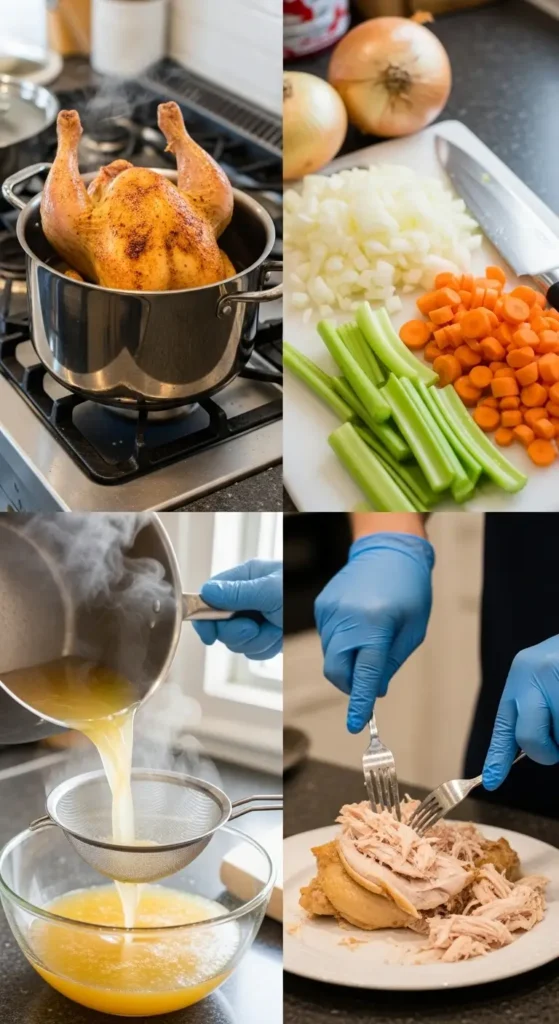
Step 1: Get that chicken golden
Heat your olive oil in a big, heavy pot. I use my Dutch oven, but any large stockpot works. Season your whole chicken with salt and pepper – like, really season it. Don’t be shy.
Brown the chicken on all sides. This takes maybe 15-20 minutes total, and your kitchen is gonna smell amazing. Don’t rush this part! Those brown bits are flavor gold. If you’re like me and constantly second-guess yourself, the chicken should be golden brown and beautiful when you’re done.
Remove the chicken and set it aside. Do NOT clean the pot. All those brown bits? We’re keeping those.
Step 2: Build your flavor base
Add your roughly chopped onion, carrots, celery, and smashed garlic to the same pot. Cook them for about 5 minutes, stirring occasionally. They don’t need to be perfect or evenly cooked. This isn’t a cooking show.
The vegetables will start to soften and pick up some of those chicken drippings. Perfect. This is what we want.
Step 3: Make the magic happen
Put your chicken back in the pot and add the water, bay leaves, and thyme. Bring it to a boil, then reduce heat and let it simmer.
Now here’s where patience becomes your friend. Let this bubble away for about 1.5 to 2 hours. I usually set a timer for an hour, then check it every 30 minutes after that. The chicken is done when it’s literally falling off the bone.
Pro tip: Don’t cover the pot completely. Leave it slightly cracked so some of the liquid can evaporate and concentrate the flavors. I learned this from watching my grandmother cook, and it makes such a difference.
Step 4: The messy part (but so worth it)
Carefully remove the chicken from the pot. It’s gonna be hot and falling apart, so use tongs and maybe a slotted spoon. Set it aside to cool while you strain the broth.
Strain all that broth through a fine-mesh strainer into another pot or large bowl. Toss out the cooked vegetables – they’ve done their job. The broth should be golden and smell incredible. If it doesn’t, something went wrong, but honestly, that’s never happened to me with this method.
When the chicken is cool enough to handle, shred it into bite-sized pieces. Throw away the skin and bones. I usually end up with about 3-4 cups of shredded chicken, which is perfect.
Step 5: Bring it all together
Put your beautiful golden broth back in the pot and bring it to a boil. Add your fresh diced carrots and celery, and cook for about 10 minutes until they’re tender but still have a little bite.
Add the egg noodles and cook according to package directions. Usually that’s about 8-10 minutes. Stir in your shredded chicken during the last few minutes to heat it through.
Season with salt and pepper. Taste as you go – this is crucial. Start with a teaspoon of salt, stir, taste, repeat. The soup should taste rich and well-seasoned, not bland or overly salty.
Stir in fresh chopped parsley right before serving. This adds a pop of color and fresh flavor that really makes the soup shine.
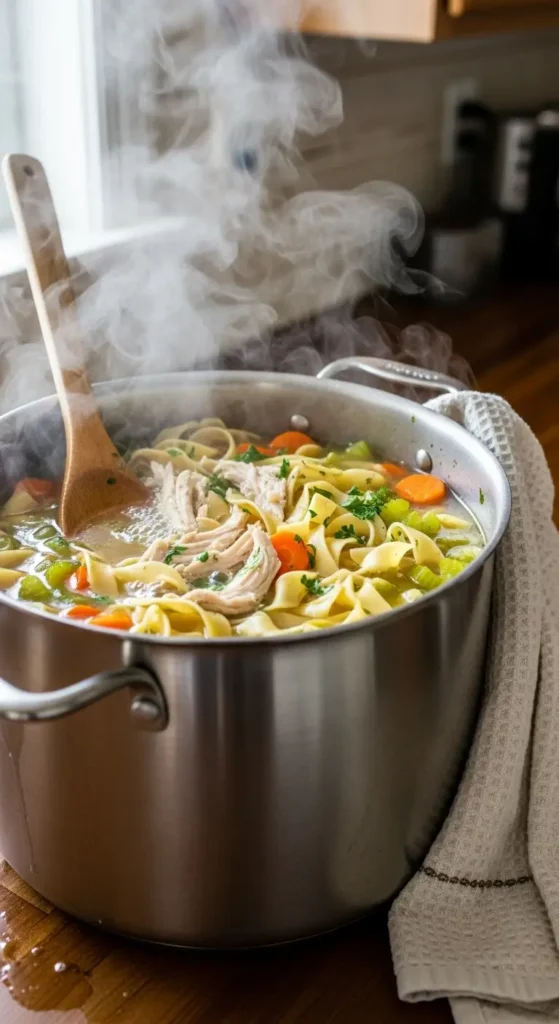
Things I Learned the Hard Way (So You Don’t Have To)
Don’t skip the browning step. I tried making this once when I was in a hurry and just threw everything in the pot together. It was fine, but it wasn’t the same. Those caramelized bits make all the difference.
Cook the noodles separately if you’re making a big batch. If you’re planning to have leftovers, cook your noodles in a separate pot and add them to individual bowls when serving. Otherwise, they get mushy and weird after sitting in the broth.
Taste, taste, taste. I can’t stress this enough. Every chicken is different, every batch of vegetables has different flavors. Don’t just follow the recipe blindly – trust your taste buds.
Don’t overthink the vegetables. Perfect dice cuts are nice, but they’re not necessary. Rustic, homestyle pieces are totally fine and honestly look more appetizing to me.
Fresh herbs matter. That handful of fresh parsley at the end isn’t just for looks. It brightens the whole soup. Dried parsley just isn’t the same.
What Makes This Different (And Why It Actually Works)
The secret is really in building those layers of flavor. Most people just throw everything in a pot and hope for the best, but taking the time to brown the chicken and then using those drippings to cook the vegetables makes such a huge difference.
Also, using a whole chicken instead of just breasts or thighs gives you a richer, more complex broth. The bones, skin, and different cuts all contribute different flavors and textures.
And honestly? Time. You can’t rush good chicken soup. Those two hours of simmering aren’t just cooking the chicken – they’re melding all those flavors together into something that tastes like it simmered all day at grandma’s house.
My 8-year-old refuses to eat anything green, but somehow loves this soup. Maybe it’s because the vegetables get so soft they’re not scary anymore, or maybe it’s just because it tastes like comfort in a bowl. Either way, I’m not questioning it.
Serving and Storage (The Practical Stuff)
This recipe makes about 8 servings, which is perfect for my family of four with leftovers for lunch the next day. I serve it with some crusty bread or saltine crackers – nothing fancy.
If you’re storing leftovers, remember what I said about the noodles. They get gross if they sit in the broth too long. I usually store the soup and noodles separately and combine them when reheating.
The soup keeps in the fridge for about 4 days and freezes really well for up to 3 months. Just don’t freeze it with the noodles – add those fresh when you reheat.
Final Thoughts (And Why You Should Try This)
Look, I’m not gonna lie and say this is the easiest soup you’ll ever make. It takes some time and attention. But it’s so worth it. There’s something deeply satisfying about making a pot of soup from scratch, especially when it turns out better than anything you can buy.
This recipe has become my go-to for sick days, cold weather, and whenever I need to feel like I have my life together. It’s also great for impressing people without actually being that complicated – they don’t need to know how many times I messed it up before getting it right.
The best part? Once you make it a few times, you’ll start to understand how it works, and then you can make it your own. Add some lemon juice for brightness, throw in some fresh dill, use rotini instead of egg noodles – whatever makes you happy.
Just promise me you won’t skip the browning step. Trust me on this one.
Now I’m craving a bowl just writing about it. Thanks a lot, brain.
Happy cooking! (And may your smoke alarms stay quiet) 🍲
Let me know how yours turns out! Seriously, I love hearing about other people’s soup adventures – and disasters.
If this recipe added a fresh twist to your table, why stop here? I’ve got a whole collection of vibrant sides that are just as easy and delicious. Take a peek at more of my favorite side dishes Here
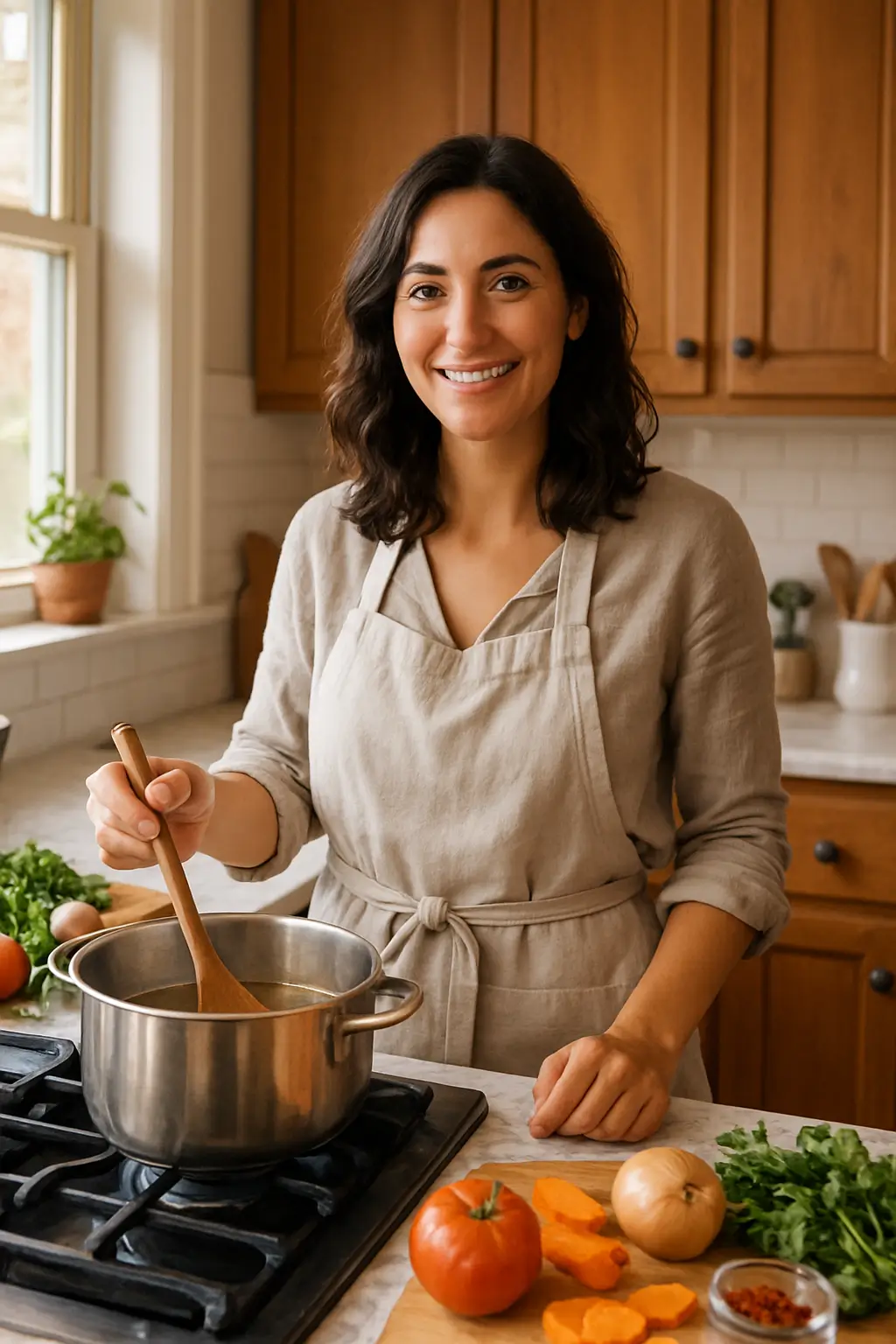
I’ve always found peace in the kitchen—it’s where I go to unwind, experiment, and reconnect. I started this blog because I wanted to share that feeling with others. My cooking journey started in a tiny apartment kitchen, with a second-hand skillet and a lot of trial and error.
Since then, I’ve learned that the best meals aren’t the most complicated—they’re the ones made with love (and maybe a little butter). Whether you’re a beginner or a kitchen pro, I hope you’ll feel right at home here.

